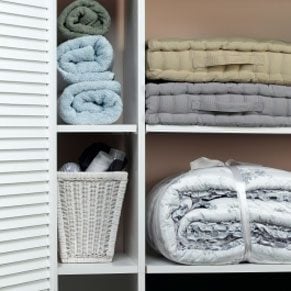The Clutter Reduction Plan
Need to get your home organized? Try these ideas for cutting the time you spend on life’s unavoidable chores-leaving you more space for the things that really matter.

Clear out the clutter
Constantly negotiating around the clutter in your home wastes time.
- Identify your clutter problem areas and deal with them one by one.
- Don’t get overwhelmed. Go into one room and identify a problem area, then work on it, or even just a section. If the whole wardrobe needs sorting, start with the sock drawer. If the kitchen looks like carnival night at the tip, clear one drawer or cupboard at a time. Time yourself and devote an hour or so per session to the task, until it’s done.
- If you’re not sure whether to keep or throw away something, ask yourself: Do I really want or need it? Is it in good order? Have I used it recently? Will I miss it?
- Be ruthless. Haven’t worn that skirt for 12 months? Give it away. Do you hate the Eiffel Tower doorstop your aunt gave you for Christmas? Take it to a charity shop.
Tackle the hotspots
Clutter can sneak up on you-one folded newspaper in the corner quickly becomes ten.
- If paperwork is your weakness, get a filing system and create a separate folder for bills due, bills paid, banking, tax documents, receipts, appliance instructions etc, and file them each day.
- Try to be realistic about recyclables: keep a few empty jars or takeaway food containers, not hundreds; one or two carrier bags or padded envelopes, not piles of them.
- Not all clutter is obvious. It can be hidden in garages and cupboards. Recognise clutter hotspots and give them regular attention.
- If you’re a hoarder, get organised about your storage and display systems, so that what you keep is not filling up your living space.
- Once you’ve got your clutter reduced, stay on top of it. All you need to do is spend a few minutes every day returning things to their proper place – this is now simple tidying, rather than de-cluttering.
Sort, store and toss
Sort clutter into labelled cardboard boxes. Try this:
- Box 1 – Everyday things that need to be put back in their place.
- Box 2 – Things to be given away or recycled.
- Box 3 – Items that you don’t need every day, but need to store.
- Box 4 – Anything that can be categorised as “absolute rubbish”.
- Box 5 – Items you simply can’t decide what to do with.
Put everything in Box 1 back where it belongs, take Box 2 to a charity shop, label and decide where to store Box 3 and dispose of the contents of Box 4. Now go back to the contents of Box 5 with a newfound zeal and make a decision.
Get more home and gardening tips when you sign up for our weekly newsletters.



